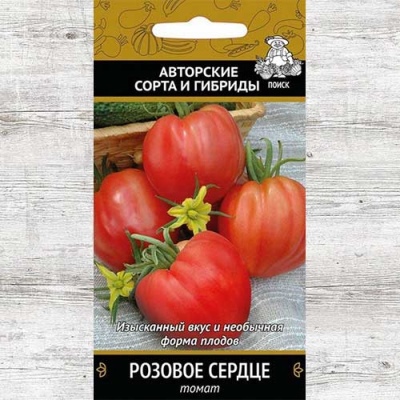
- Authors: S. V. Maksimov, N. N. Klimenko, A. N. Kostenko, LLC Agrofirma "Poisk"
- Year of approval: 2007
- Category: grade
- Growth type: indeterminate
- Appointment: fresh consumption, for juice
- Ripening period: early
- Ripening time, days: 85-90
- Growing conditions: for open ground, for film greenhouses
- Bush size: tall
- Bush height, cm: 150-200
Tomato Pink Heart has long established itself as it tastes great and gives a good harvest. Its popularity is growing every year. In this article you will find a description of the Pink Heart tomato and learn the features of caring for it.
Description of the variety
The described variety was approved for use in our country in 2007. It is an indeterminate varietal plant, with fruits that are used fresh and juiced from them.
The Pink Heart is planted in open ground and film greenhouses. The bushes are up to 2 meters high.
The main qualities of the fruit
The fruits are pink when ripe. Quite large, weighing up to 230 grams. The pulp inside is not too dense, fleshy.
Taste characteristics
The taste is pleasant.
Ripening and fruiting
The pink heart is an early variety that ripens in a maximum of 90 days. Harvested from July to August.
Yield
This figure is at the level of 6.1 kg / sq. m.
The timing of planting seedlings and planting in the ground
From 10-20 March, seedlings are sown. Young bushes are moved into the ground from May 10-20.

Growing tomato seedlings is an extremely important process, because it largely depends on whether the gardener will be able to harvest at all. All aspects must be taken into account, from seedbed preparation to planting in the ground.
Landing scheme
The landing pattern used is 60x40 cm.

Growing and care
The seeds of the Pink Heart are soaked in a weak solution of potassium permanganate for 20-25 minutes to destroy microorganisms that cause various diseases.
Important! To speed up germination, the seeds can be wrapped in cheesecloth. Do not let it dry out, and do not allow excessive moisture.
To make tomatoes more resistant to temperature changes, follow these steps: chill the seeds for 10-12 hours in the refrigerator, and then soak at a temperature of 18-22 degrees. Repeat this procedure several times.
Sowing depth and scheme of tomato pink heart is almost no different from other varieties of tomatoes. Seeds for growing seedlings are sown in boxes to a depth of about 1-1.5 cm, then covered with a thin layer of earth, lightly watered and covered with foil. The containers are placed on a windowsill or other sunny place.
It is recommended to add a growth stimulator to the soil where the Pink Heart tomato is sown. In stores, you can buy special nutrient soil to grow seedlings, and you can also easily prepare it yourself. The same amount of earth and 6-7 parts of peat, as well as 2 parts of humus, are added to one part of the mullein. The soil must be monitored to keep it loose, moist and free of weeds.
The pink heart tomato can be planted both in the greenhouse, which contributes to the earlier ripening of the fruit, and in the open field.
Before planting tomato seedlings of this variety in open ground, it is necessary to prepare the soil.To do this, a week before planting, you can add a solution of copper sulfate to it. Then we fertilize the soil with mineral and organic fertilizers. 10 kg of humus, half a bucket of wood ash and 50-70 grams of superphosphate are added per square meter. The site is being dug up.
Planting young bushes of the Pink Heart is necessary when the seedlings reach at least 25 cm in height, and their root system is sufficiently developed.
Tomatoes of this variety grow well on light soils with a slightly acidic or neutral reaction. The optimal acidity is 6.0-6.7. It is recommended to plant pink heart tomatoes after crops such as cucumbers, onions, potatoes, zucchini, carrots, pumpkin. It is not recommended to plant a tomato in the beds where eggplants, peppers, physalis grew.




A plant needs different micronutrients at each stage of growth. All fertilizers can be divided into two groups: mineral and organic. Folk remedies are often used: iodine, yeast, bird droppings, eggshells.
It is important to observe the rate and period of feeding. This also applies to folk remedies and organic fertilizers.
Disease and pest resistance
The tomato of the described variety has good immunity to the following diseases:
alternaria;
cracking of fruits;
cladosporiosis;
tobacco mosaic virus.



























































































